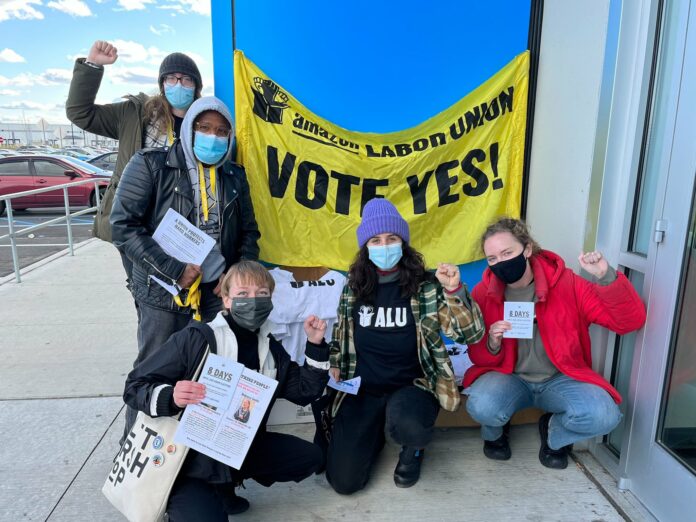Earlier this month, the Amazon Labor Union (ALU) was officially formed after thousands of workers at the JFK8 fulfillment center on Staten Island voted to unionize. Now ALU is taking on Amazon again right across the street, at the LDJ5 sort center which employs 1,500 people. Voting has started this week and results will be announced on May 2, unless Amazon plays dirty tricks to challenge the results.
In terms of organizing the unorganized, a victory at LDJ5 would be the third largest union election victory in the last twelve months (JFK8 is the largest). In terms of significance to the future of the labor movement, a victory at LDJ5 would consolidate an important beachhead in the fight to unionize Amazon, one of the fastest growing corporations on the planet, which employs 1.1 million workers and owns enough building space to enclose half of Manhattan.
It’s essential to apply the lessons from JFK8, organizing around clear demands, building a democratic worker-led committee, and clearly naming a boss like Jeff Bezos as the enemy. However, applying these lessons at LDJ5, a different facility, with different workplace conditions, workplace issues and with less time to prepare, poses unique challenges for the struggle at LDJ5. With larger unions like The Teamsters motioning that they will launch their own attempts to unionize Amazon, the floodgates are already open, though the outcome of LDJ5 will have a big impact on how things develop.
Apply The Lessons of JFK8 To The Fight To Unionize LDJ5
As ALU prepares for the last days of the election to unionize LDJ5, and unionization campaigns are sprouting up in North Carolina and other warehouses across the country, it’s essential to apply all the lessons of the historic JFK8 victory. The ALU campaign at JFK8 bore no resemblance to the conventional unionization campaigns or contract battles we’ve seen over the past several decades under the existing leadership of the unions. Campaigns where the union timidly seeks peace with the boss.
ALU approached other workers with politicized slogans like “do you support ALU? We’re fighting for a $30/hr starting wage.” The rest of the union’s program for 100 hours paid time off, paid 30 minute breaks, ending mandatory overtime, and allowing access to phones during work (a no-brainer for parents dealing with the pandemic), were developed organically from conversations between workers.
The campaign to win at JFK8 involved relentless shop-floor organizing. The strategy and tactics of the campaign were determined by the people most familiar with the needs of the workers at JFK8: the workers themselves. Where they should set up, what they should lead with, what material they should pass out and in what languages. All of these key decisions were made by a tight organizing committee of workers themselves, not by union staff outside the workplace.
Three, ALU made clear from day one that the fight for a union would put them in direct conflict with Amazon. There would be no peaceful partnership between the workers and the billionaire executives whose needs are at complete odds. Every cent Jeff Bezos spent sending himself into space came directly out of the paychecks of Amazon workers. This means every additional cent we win with a union contract will come out of the paychecks of their billionaire executives.
Exporting the victory at JFK8 to warehouses across the country and the world will mean holding true to these three key methods. The battle to unionize Amazon, the second largest private employer in the country, can’t be won without a transformation of the existing labor movement. It’s a massive step forward that elected leaders in ALU will receive the average wage of the workers they represent, including the president. This is something almost unheard of in an era where labor leaders regularly make six figures (something union-busting corporations draw attention to to claim the union has separate interests than the workers themselves). Socialist Alternative member and Seattle City Councilmember Kshama Sawant also only accepts the average wage of a resident she represents and she recently donated $20,000 of her salary to ALU.
“Defeated Armies Learn Their Lessons” – Don’t Underestimate Amazon
Amazon also knows the stakes are high at LDJ5, and they are doing everything they can to intimidate, manipulate, and confuse workers into voting “no” to the union. Amazon is covering the inside of the warehouse in large banners and stickers on every pillar encouraging workers to vote no. In addition, they are mailing propaganda to every worker with the slogan “you can’t test drive the union” and “ALU” written across a cartoon car. Besides being a lie (workers will be able to vote on every word of their contract!) it’s a dog whistle to another baseless attack that Amazon’s union-busting spies are spreading around the warehouse: that ALU leaders are spending union money on fancy sports cars.
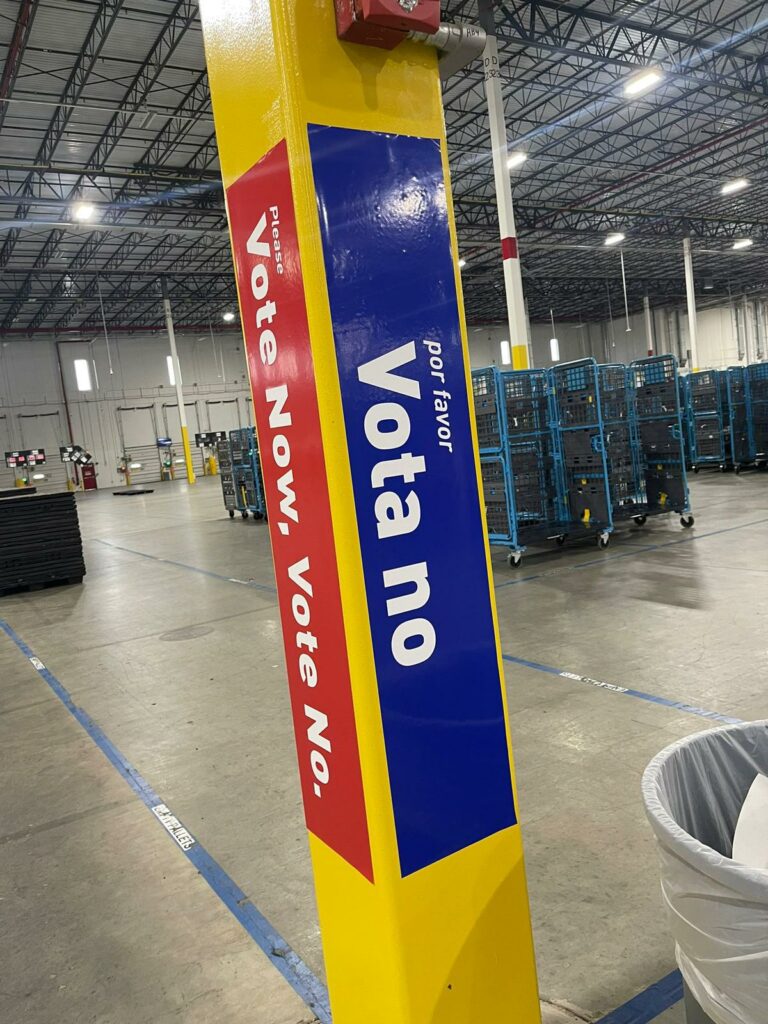
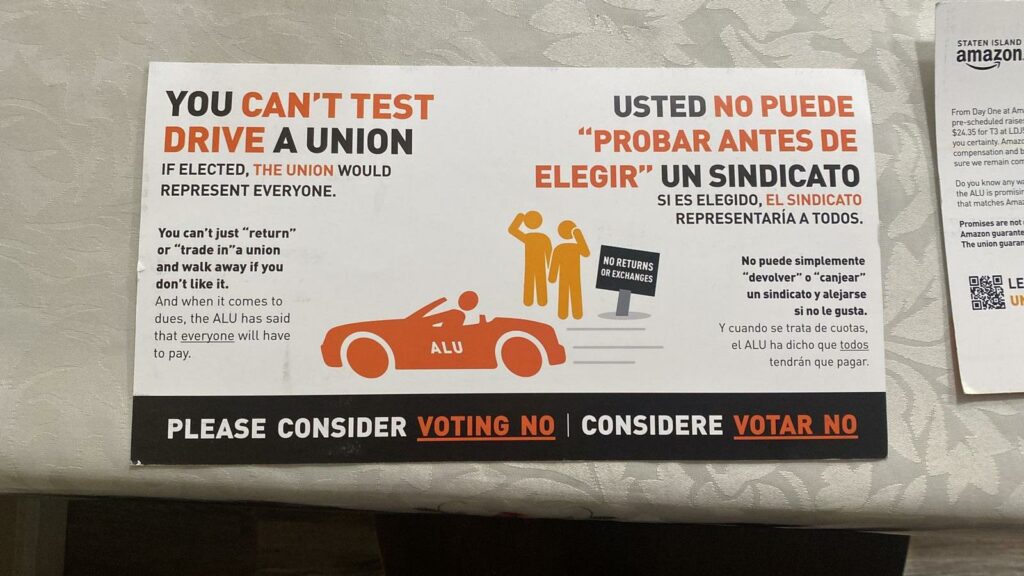
ALU has done an excellent job exposing Amazon’s anti-union propaganda. Every day, there is a new ALU leaflet debunking outlandish lies Amazon’s spies spread that day, and generally useful articles answering basic questions about unions right on their website. For example, ALU’s “no dues without a raise” leaflet is effective at linking the need for membership dues with the need for workplace struggle, while also cutting across Amazon’s talking points about union dues. Furthermore, ALU is willing to polarize around Amazon’s well established track record of lying about unions, which helps build the confidence of pro-union workers to openly confront managers in the anti-union “captive audience” meetings happening every day.
At LDJ5, Amazon is trying out new anti-union tactics that include the use of right-wing talking points, manipulation, and high paid spies. Amazon is encouraging workers to “do their own research.” The right-wing regularly uses this talking point to create artificial debate around issues like climate change. Of course workers should do their own research, but that research should include talking to their co-workers, something Amazon is discouraging.
Amazon has gone to great lengths to make the point that workers at JFK8 and LDJ5 have nothing in common and that JFK8 ALU organizers are not to be trusted. With only one other Amazon warehouse in the country successfully unionized, this can be an effective argument for them. They will insist that the union victory at JFK8 was a fluke. Overcoming this lie at LDJ5 will require the maximum unity of workers at the four neighboring Amazon facilities who are all suffering under similar, though not identical, conditions. ALU organizers regularly make the point that winning a good contract at JFK8 will be dramatically aided by a victory at LDJ5. This will need to be a central talking point in these final days.
Amazon is encouraging pro-union workers to “think about their co-workers.” To Amazon, this means whipping up fears that certain benefits will be taken away by the union, and then encouraging these terrified workers to speak up at the anti-union meetings. Amazon claims the union will be a “third party”, even though the union is made up of the workers themselves. Ironically, Amazon is perfectly willing to pay professional, third party consultants thousands of dollars a day to walk the shop floor pretending to be fellow workers.
There is no way to know how much of an impact Amazon’s anti-union campaign will have among LDJ5 workers until the votes have been counted. Amazon’s high paid union busting consultants are so good at tricking workers into voting against their own interests, that many of these union-busters come from the commanding heights of the Democratic Party. However, every dollar Amazon spends on union-busting consultants also undermines their central anti-union talking point. Why spend so much to keep the union out if it’s true the union won’t really help workers?
A Strategic Crossroads for Labor
Amazon sits at the strategic crossroads of the logistics sector and the growing “gig” economy. In 2020, Amazon’s shipping increased 20% in a single year, and they built 220 new facilities across the country, including the BHM1 facility in Bessemer, Alabama – where a second unionization attempt fell short. They now ship more packages than FedEx and are approaching UPS. They own 80 cargo jets, enough to occupy half of the gates at JFK airport, and have purchase orders in place to surpass DHL’s 180 jets in the next few years.
This empire is based on the extreme exploitation and burnout of Amazon workers. The 150% employee turnover per year at their warehouses is the result of a toxic corporate culture at the very top. In a 2003 letter to shareholders, Jeff Bezos claimed if Amazon became a “a country club” like Microsoft, “we would die.” One Amazon Human Resources executive described their work culture as “purposeful Darwinism.” Between 2013 and 2018, a Daily Beast investigation found that 911 was called to Amazon warehouses 189 times after reports of suicide attempts.
Presiding over all of Amazon is Jeff Bezos, the world’s second richest billionaire. While a half a million people died of preventable COVID deaths, tens of millions lost their jobs and renters fell behind on rent, Bezos made $80 billion dollars. His total personal wealth is $190 billion – slightly less than the annual GDP of Greece. It’s easier to think of Bezos’ wealth in terms of time. Count to ten as quickly as you can, and Bezos made $2,000. Hold your breath as long as you can, and he probably made over $150,000. The average U.S. worker would need to work 10 times the length of all human history to earn as much as Jeff Bezos has.
A second victory at LDJ5 would draw a straight line towards the broader unionization of Amazon – though this would not come automatically – and it would cut across Amazon’s attempts to explain away the JDK8 victory as an enigma, unique to this one facility in New York. It would show other workers that megacorporations can be unionized, and it would show that workers at high turnover jobs can be unionized.
Many of the demands ALU is emphasizing – $30/hr minimum wage, paid breaks, the brutal deskilling of work through the arbitrary Time Off Task system, ending unfair scheduling like mandatory overtime – resonate far beyond Amazon. These demands could give an organized expression to deeper molecular processes taking place among the working class, like The Great Resignation.
All Eyes on LDJ5
The broader drive to unionize Amazon will still come down to fights at individual facilities which have their own unique characteristics, challenges, and opportunities. There will be breakthroughs and setbacks. In sports, the overall process of winning the game is the sum total of every point scored, the dynamics of every play, and the characteristics of every player. Sometimes the losing team scores goals along the way.
ALU’s breakthrough victory at JFK8 has raised the potential for a broader drive to unionize Amazon, but momentum alone doesn’t guarantee a victory in this week’s election at LDJ5. Many LDJ5 workers spent time fighting to ensure a victory at JFK8, only to turn around days later to ramp up the campaign in their own workplace. This means they had less time to build a robust organizing committee in the leadup to the election, though lead organizers have done heroic work in the final two weeks of the campaign to build out a wider team.
LDJ5 is a sort center which makes it a different part of Amazon’s supply chain with unique features. Most workers are part-time. Turnover is high and many work other jobs on top of LDJ5. This means that ALU has had to emphasize different demands in the drive at LDJ5. While longer breaks are not as popular a demand for workers who work four-hour shifts, there is a strong desire for more full-time positions at the facility on top of higher wages. LDJ5 organizers circulated surveys in the break room in the days leading up to the vote to determine the key demands that their coworkers would want to fight for with a union.
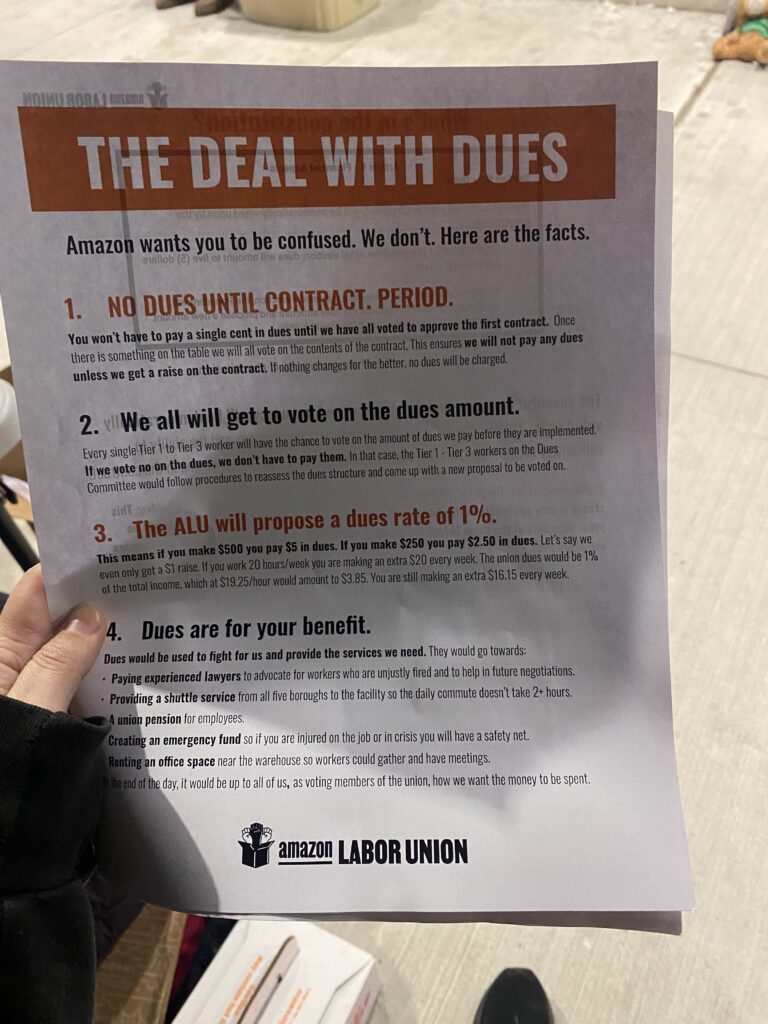
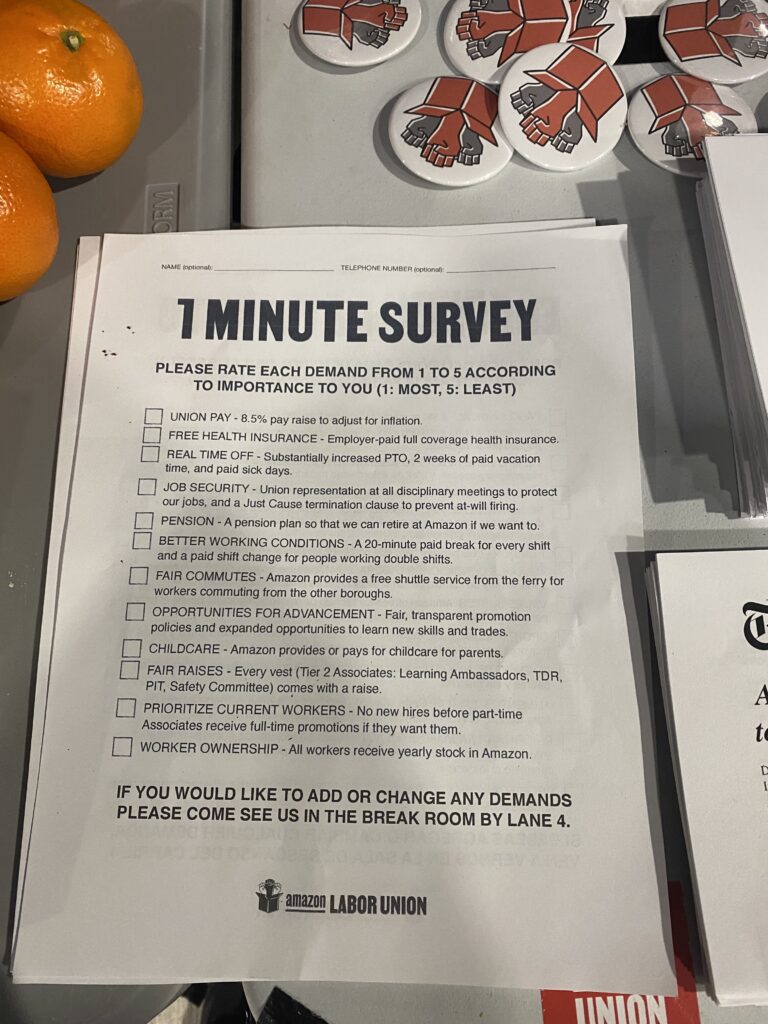
While it’s clear we can’t copy and paste the exact same demands used in organizing fulfillment centers, it would be a huge mistake to look at the unique features of sort centers and conclude that a whole section of Amazon’s supply chain cannot be organized. If this were true, Amazon would not be fighting so hard to keep the union out, spending millions on union-busting consultants who are using ever more cunning, dishonest, and manipulative tactics. In fact, unionizing every part of Amazon’s supply chain under one banner will be essential to winning good contracts.
On May 2nd, when the results of the election are announced, both Jeff Bezos and Amazon workers across the country will be eagerly watching the results and preparing to learn the lessons for the next phase of the struggle.


